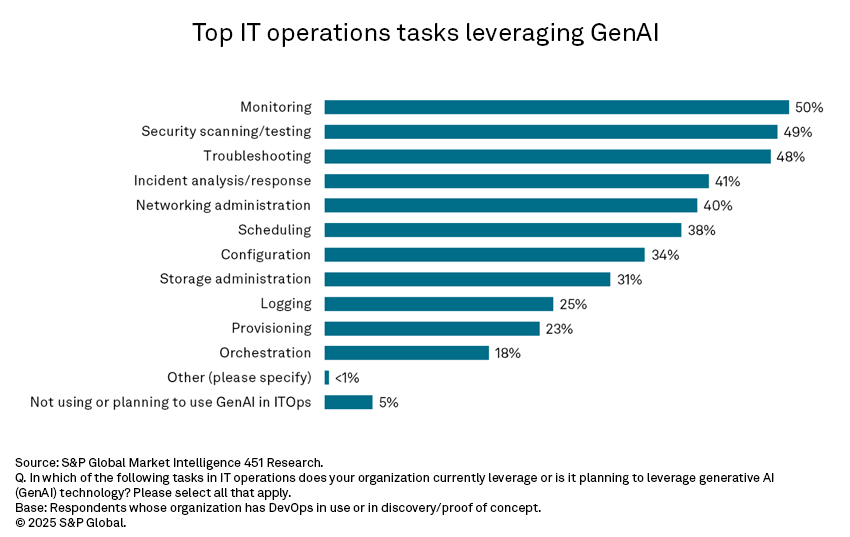
Source: Tom Werner/DigitalVision/Getty images.
Organizations’ use of generative AI for IT operations continues to grow, with nearly three-quarters of organizations leveraging it for at least one task. However, several core components of IT operations remain in the hands of traditional teams, and organizations generally cite a need to maintain or increase staff recruitment and retention as they implement GenAI for IT operations, according to a recent study conducted by S&P Global Market Intelligence 451 Research on the topic of DevOps and GenAI in IT operations.
The Take
The survey indicates growing adoption of GenAI for IT operations, particularly for monitoring, security scanning and troubleshooting. However, many core IT tasks, such as orchestration, configuration and provisioning, remain mostly the responsibility of traditional DevOps, platform engineering and IT operations teams. This coincides with a general increase in staff required for implementing GenAI in IT ops, while a lack of skills is among the top challenges. Despite continued integration of GenAI in IT operations, human staff and collaboration remain critical to implementation. Our results also highlight that GenAI can be used to free up staff for creative efforts and interactions that can drive both efficiency and innovation, while a loss of human creativity is among organizations’ concerns about leveraging GenAI for IT operations.
Summary of findings
Organizations are broadly adopting GenAI for IT operations, with 74% of respondents saying it is in use for at least one task. Organizational priorities for these deployments include improving team efficiency (58%), supporting end-to-end automation (45%), and enhancing focus on business objectives and outcomes (43%). Observed or expected benefits include more efficient use of personnel (49%), faster problem solving/issue resolution (48%), improved end-user experience (43%), improved developer productivity (40%) and more accurate data (40%). As with the broader DevOps trend, a maturing market adopting GenAI for IT operations is increasingly focused on benefits beyond speed, including business and end-user outcomes.
The top IT operations tasks leveraging GenAI are monitoring (50%), security scanning/testing (49%) and troubleshooting (48%), consistent with our 2024 survey (see Figure 1). Monitoring, observability and security are broadly identified as areas of opportunity for automation. This also reflects an evolving market where the preferred approach is to focus on smaller tasks to integrate and automate with GenAI, rather than trying to integrate it throughout IT operations all at once. This more gradual, granular approach also appears to be helping organizations better prepare to measure and manage their progress with implementing GenAI for IT operations.

Notably, core IT operations components such as configuration (34%), provisioning (23%) and orchestration (18%) are less common areas to leverage GenAI, indicating these critical tasks still require human staff and expertise. This relates to a broadly identified need to maintain or increase staff retention and recruitment to leverage GenAI in IT operations. Nearly a quarter of respondents (22%) report that GenAI adoption is resulting in a significant increase in IT staffing needs and 35% indicate a slight increase, while 22% indicate no effect, 18% indicate a slight decrease, and only 3% report a significant decrease. We noted similar responses regarding GenAI’s impact on staffing for software development, highlighting that skills and expertise in both domains are critical to successful GenAI implementation.
In observability, GenAI is being used to recommend problem resolution (53%), automate data management (52%), provide interactive chatbot interfaces (41%), and provide contextual, automated workflow management (41%). AI, along with cloud-native designs and the rising importance of data integrity, user experience and regulatory compliance, is critical as observability evolves in the organization. Based on S&P Global Market Intelligence 451 Research’s recent survey focused on cloud native and observability, we expect to see AI use and confidence continue to grow as organizational deployments mature and observability vendors better tune their output and customer expectations.
The top challenges that organizations face or expect to face when using GenAI in IT operations include cost (41%), data/IP sensitivity (38%), lack of skills/talent (34%), complexity (33%) and measuring effectiveness (33%). While most organizations recognize the need and benefit of adopting GenAI, cost concerns persist given significant expenses related to staff, time and resources (e.g., CPU, GPU, memory, power). Data and intellectual property concerns also consistently appear among the hurdles to implementing GenAI in IT operations. Similarly, organizations’ top concerns about using GenAI for IT operations include data privacy and security risks (44%), skills and training required (37%), and use of IT resources (35%), as well as loss of human interaction (31%), loss of human creativity (30%), and legal and regulatory compliance concerns (30%).
Do you have your finger on the pulse of tech trends? Join the 451 Alliance for exclusive research content on industry-wide IT advancements. Do I qualify?

